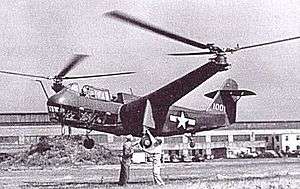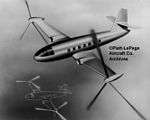Platt-LePage Aircraft Company
The Platt-LePage Aircraft Company was a manufacturer of aircraft for the armed forces of the United States of America. Based in Eddystone, Pennsylvania, the company produced the first helicopter to be officially acquired by the United States Army Air Forces.
| Industry | Aircraft manufacture |
|---|---|
| Fate | Dissolved |
| Founded | 1938 |
| Founder | Wynn Laurence LePage Haviland H. Platt |
| Defunct | 1947 |
| Headquarters | , United States of America |
Key people | R. Allen Price Elliot Daland Frank Piasecki Donald Beatty |
| Products | XR-1 |
Establishment
Wynn Laurence LePage, a British Aeronautical Engineer living in Pennsylvania, who co-founded the Platt-LePage Aircraft Company in partnership with Haviland Hull Platt, the company's intended purpose being the manufacture of helicopters.[1] LePage, impressed by the performance of the German Focke-Wulf Fa 61,[2] acquired the manufacturing rights to the aircraft.[3]
Two early helicopter prototypes developed by the company failed to meet with any success;[4] however in 1940, under the terms of the Dorsey-Logan Act,[5] Platt-Lepage was declared the winner of a competition to supply the Army with its first helicopter.[6]
First Army helicopter

Having employed designer Grover Loening as a consultant[4] and helicopter enthusiast Frank Piasecki employed as a junior engineer,[7] Platt-Lepage set to work developing the helicopter, using a similar rotor arrangement to that of the Fa 61.[8] The aircraft, designated XR-1, flew three months behind schedule in 1941.[9]
The XR-1 suffered from significant teething troubles, including control difficulties, vibration, and resonance issues,[5] and financial difficulties at Platt-LePage caused significant delays in resolving the aircraft's problems.[9] Despite this, the USAAF still believed the XR-1 would prove successful,[10] however the improved XR-1A, flying for the first time in 1943, proved little better than its predecessor, and was damaged in an accident in early 1944.[9]
With Piasecki having left the company,[11] the XR-1's flight testing dragged on through 1944.[9] The Army Air Forces, spurred by Congressional accusations of favoritism towards Vought-Sikorsky, ordered seven YR-1A service-test helicopters.[12] Despite this, Sikorsky's R-4 was proving far superior to the Platt-LePage aircraft, having successfully passed its flight trials and already entering operational service with the Army.[9] Therefore, in early 1945 the Army elected to cancel its contracts with Platt-LePage.[9]
Disestablishment

The repaired XR-1A was purchased by Helicopter Air Transport, which intended to operate it for commercial purposes[12] as part of a fleet of 40 helicopters.[13] The company had also developed a number of other concepts for helicopters, including the PL-11, an improved civilian version of the XR-1A; the PL-12, a four-passenger variant of the PL-11; and the PL-14, a twin-rotor helicopter based on a Grumman Widgeon fuselage.[14] In addition, a design for a tiltrotor airliner was developed by the company.[15]
However, the cancellation of the company's Army contracts had removed Platt-LePage's primary source of income, and without sufficient funds to continue operating, the company closed its doors on January 13, 1947.[16] McDonnell Aircraft, which had acquired part of the company in 1942,[17] and a larger share in 1944,[2] purchased the rights to the remainder of the company's intellectual property,[16] including the design for the PL-9, a twin-engine helicopter that McDonnell would develop into the XHJD Whirlaway.[18]
References
- Notes
- McGowen 2005, p.18.
- Francillon 1990, p.48.
- Raines 2002, p.42.
- Charnov 2003, pp.171.
- Leishman 2006, p715.
- Pattillo 2000, p.142.
- Charnov 2003, pp.183.
- McGowen 2005, p.19.
- Francillon 1990, p.50.
- Uttley 2001, p.40.
- Pattillo 2000, p.143.
- Francillon 1990, p.51.
- Wood, Robert H. Aviation News Volume 7, p.13. New York: McGraw-Hill, 1947.
- "American airplanes: Pl-Py". Aircraft of North America 1903–2003. Aerofiles.com. 2009. Retrieved 2010-12-02.
- Boyne 2002, p.78.
- Pattillo 2000, p.189.
- Francillon 1990, p.8.
- Pattillo 2000, p.191.
- Bibliography
- Boyne, Walter J. (2002). Air Warfare: An International Encyclopedia. Santa Barbara, CA: ABC-CLIO. ISBN 978-1-57607-345-2. Retrieved 2010-12-02.
- Charnov, Bruce H. (2003). From Autogiro to Gyroplane: The Amazing Survival of an Aviation Technology. Westport, CT: Praeger. ISBN 978-1-56720-503-9.
- Francillon, René J. (1990). McDonnell Douglas Aircraft since 1920: Volume II. Annapolis, MD: Naval Institute Press. ISBN 1-55750-550-0. Retrieved 2010-12-01.
- Leishman, J. Gordon (2006). Principles of Helicopter Aerodynamics. New York: Cambridge University Press. ISBN 0-521-85860-7.
- McGowen, Stanley (2005). Helicopters: An Illustrated History of Their Impact. Weapons and Warfare. Santa Barbara, CA: ABC-CLIO. ISBN 978-1-85109-468-4. Retrieved 2010-12-01.
- Pattillo, Donald M. (2000). Pushing the Envelope: The American Aircraft Industry. Ann Arbor, MI: University of Michigan Press. ISBN 978-0-472-08671-9. Retrieved 2010-12-01.
- Raines, Edgar F., Jr. (2002). Eyes of Artillery: The Origins of Modern U.S. Army Aviation in World War II. Honolulu, HI: University Press of the Pacific. ISBN 978-1-4102-0151-5. Retrieved 2010-12-01.
- Uttley, Matthew (2001). Westland and the British Helicopter Industry, 1945-1960. London: Frank Cass Publishers. ISBN 0-7146-5194-X. Retrieved 2010-12-01.